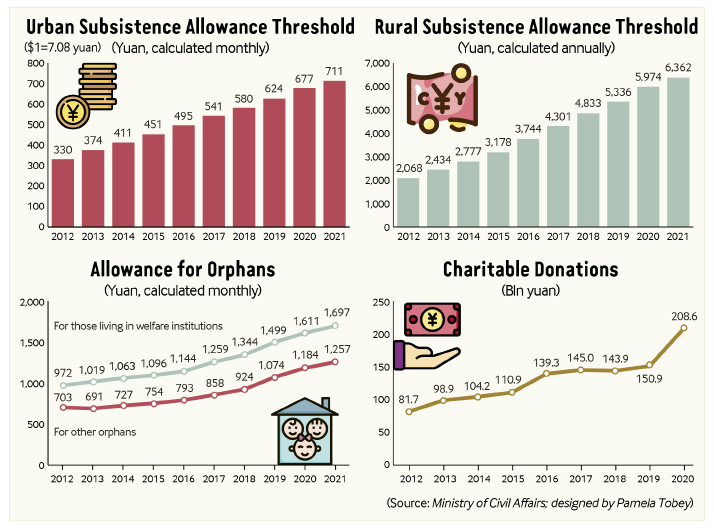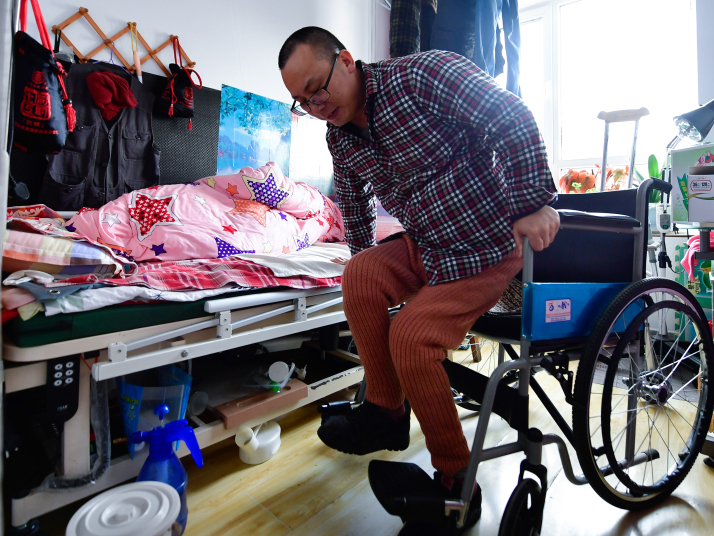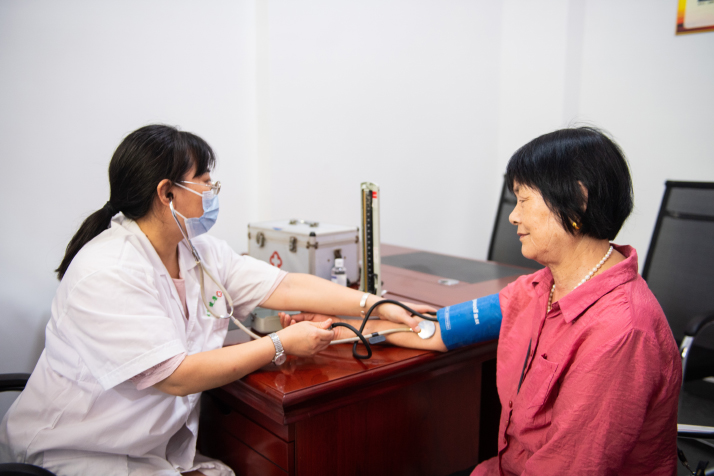| China |
| Social welfare measures ensure no family is left behind | |
|
|
 The civil affairs authorities have worked to increase welfare payments and improve grassroots governance and basic social services over the past decade, Zhan Chengfu, Vice Minister of Civil Affairs, said at a press conference on September 9.
Improvement in the welfare system has not only enhanced people's wellbeing but also contributed to social stability.  A resident with disabilities at home in Xining, Qinghai Province, on January 20, 2020. His wheelchair and bed were provided for free by local civil affairs authorities (XINHUA) Improving welfare China's welfare system has provided assistance to more than 40 million people living on the minimum subsistence allowance, 5 million people living in extreme difficulties, and to homeless people more than 2.3 million times every year on average over the past 10 years. All families with per-capita incomes lower than the subsistence allowance threshold announced by the government are entitled to this allowance which supplements their income until it reaches the threshold. People living with extreme difficulties include seniors, minors and those with disabilities who have no capacity or means to support themselves. The average minimum subsistence allowance standards for urban and rural residents increased by 1.2 times and 2.1 times respectively from 2012 to 2021. The subsistence allowance for those living in extreme difficulties had reached at least 1.3 times of the usual local minimum subsistence allowance by 2021. Over the past decade, all levels of government have spent 2.04 trillion yuan ($290.9 billion) on basic living allowance funding, ensuring the minimum living allowance and other assistance funds are issued in full and on time and guaranteeing people in difficulties can meet their basic needs. The minimum subsistence allowance system has played an important role in eliminating absolute poverty and building a moderately prosperous society in all respects. During the poverty alleviation process, 19.36 million registered impoverished people were covered by the minimum subsistence allowance system or the relief and support system for people in extreme difficulties, accounting for 19.6 percent of poor people who have moved out of poverty in the past decade. China eradicated absolute poverty by the end of 2020. The Ministry of Civil Affairs (MCA) has established a low-income population information platform. The platform has collected the basic information of more than 62 million low-income people, accounting for 4.4 percent of the total population in China. The ministry has offered assistance based on the information provided by the platform to make it more targeted and effective. In terms of welfare for the elderly, a system consisting of old-age allowance, elderly care service subsidies and nursing care subsidies for elderly people with disabilities has been established, which has benefited 30.69 million, 4.48 million and 789,000 senior people, respectively. To date, 14.2 million and 3.71 million senior citizens are covered by the minimum subsistence allowance system or the relief and support system for people in extreme difficulties, respectively. Children's welfare has improved. The allowance provided to orphans has been increased. There are 169,000 orphans in China at present. The average subsistence allowance for orphans living in welfare institutions and those staying with families have now reached 1,728 yuan ($246.4) and 1,288 yuan ($183.7) per person every month respectively, increasing by 77.9 percent and 83.1 percent respectively from 2012. China has also expanded the coverage of the allowance system for orphans to include 340,000 de facto unattended children into the system since 2020. An allowance system for people with disabilities having financial difficulties and people with severe disabilities has been set up, which has benefited 11.81 million and 15.32 million people with disabilities respectively. Construction of welfare institutions in the mental health sector has increased. China has spent 6.9 billion yuan ($983.9 million) on building or renovating mental health welfare institutions.  A doctor takes a senior citizen's blood pressure at a center for the elderly in Hanshou, a county in Hunan Province on July 20 (XINHUA)
Social governance The government has created a sound environment for the development of social organizations, especially charity organizations. The Central Government has earmarked special funding for social organizations to carry out social services every year and the State Council has consulted with industry associations and chambers of commerce when drawing up administrative regulations and government documents. Social organizations have developed rapidly in the past 10 years. There are some 900,000 registered social organizations at present, 150 times of the number when the reform and opening up started in the late 1970s and early 1980s. In the past decade, 729 national and 69,699 local trade associations have severed all financial, operational, organizational and personnel ties with the government under a reform scheme, and become independent social organizations. A large number of community social organizations have emerged, which engage ordinary citizens in various undertakings. The number of registered charity organizations has surpassed 10,000. In 2020, China's charity donations surpassed 200 billion yuan ($28.5 billion), increasing by 155 percent from 2012. Internet charity is thriving, with the donations raised on the Internet increasing by more than 20 percent every year on average. Since 2012, all kinds of social organizations have taken an active part in the poverty alleviation campaign, implementing more than 92,000 poverty alleviation projects and channeling 124.5 billion yuan ($17.7 billion) of funding into the drive. Social organizations have also played a role in safeguarding a fair market order by participating in the formulation of 2,499 national standards and 364 international standards. At present, non-profit private elderly care institutions account for 44.7 percent of the total in China, which is a large share. Chen Yueliang, an official with the MCA, said community governance has made strides in the past decade and grassroots-level democracy has further developed. "We have continuously improved the community-level self-governance system to ensure people are the masters of the country," he said. The achievements have been made under the strong leadership of the Communist Party of China. The Party's leadership of social organizations and charity work has strengthened. As of the end of last year, there were 171,000 grassroots Party organizations within social organizations. The Party's leadership of villages and communities has also strengthened. In more than 90 percent of villages and communities the positions of village or community head and Party committee chief are concurrently held by the same person, increasing by approximately 30 percent since 2012. The roles of community workers in social governance have become more prominent. During poverty alleviation, village leaders have led people to increase income and rise out of poverty. In the nearly three years of COVID-19 pandemic prevention and control, the more than 4 million community workers have played an important role. Community workers have increased in caliber. The proportion of heads of villagers' committees in rural areas and residents' committees in urban areas with college degrees or above has reached 46.4 and 82.6 percent respectively. Being young, competent and having a strong academic background have become the characteristics of community workers in the new era.  A community worker disinfects a COVID-19-affected area in Beijing on April 28 (XINHUA)
The various social services such as elderly care services overseen by the civil affairs administrations have improved in the past decade. The coverage of community service facilities in urban areas has increased from 82 to 100 percent at present, and the coverage of those in rural areas from 31.8 to 79.5 percent in the past 10 years. The elderly care services system has been constantly improved, with service supply increased. There are 360,000 elderly care institutions and facilities with 8.13 million beds and the number of beds is twice that in 2012. Community care for the aged has developed rapidly. There are 320,000 community elderly care institutions and facilities, accounting for 88.9 percent of the total. "Ensuring people live a good life is the starting point and final goal of our work," Zhan said at the press conference. (Print Edition Title: Basic Safety Net) Copyedited by G.P. Wilson Comments to jijing@cicgamericas.com |
|
||||||||||||||||||||||||||||
|
